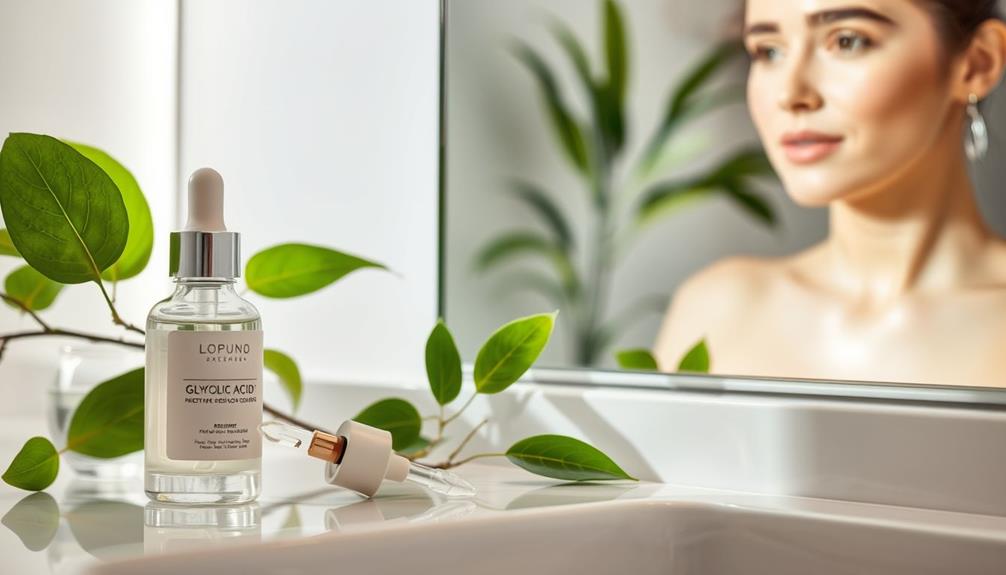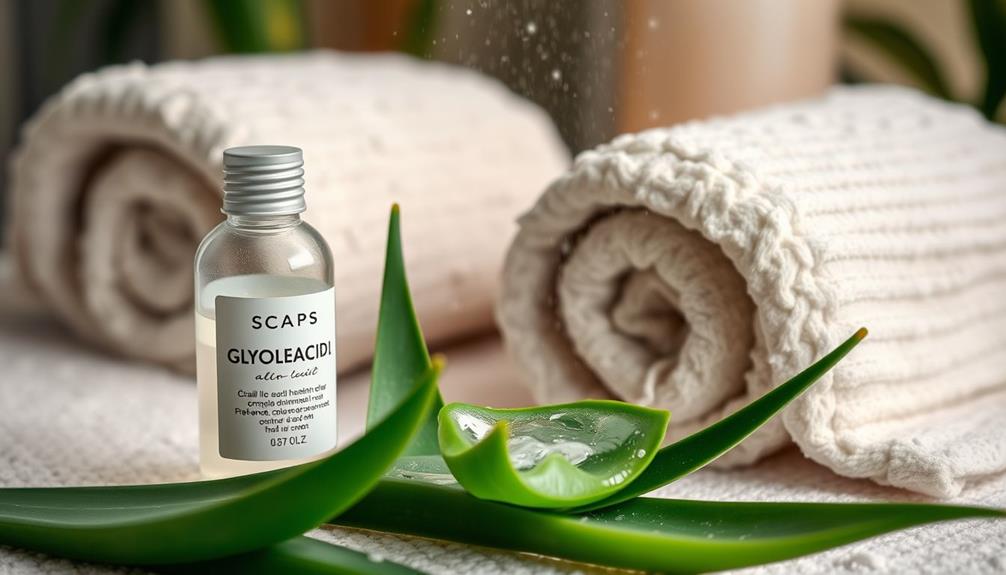Glycolic acid's a powerful alpha hydroxy acid that helps treat acne effectively. It exfoliates your skin, unclogs pores, and reduces inflammation, improving overall texture. You'll notice fewer breakouts and a reduction in acne scars with regular use. Start with lower concentrations to assess your skin's reaction, applying it a few times a week. Always follow with a moisturizer and use sunscreen to protect against increased sun sensitivity. While it's highly effective, you may want to monitor for irritation. Curious about tailored treatments and expert tips? There's more to discover about maximizing your results with glycolic acid.
Key Takeaways
- Glycolic acid, a potent AHA, promotes skin exfoliation, enhancing cell turnover and effectively treating acne by unclogging pores.
- Regular use of glycolic acid can reduce breakouts, improve skin texture, and minimize acne scars and post-inflammatory hyperpigmentation.
- Starting with lower concentrations (5-10%) is recommended to assess skin tolerance and prevent irritation, gradually increasing frequency based on individual response.
- Professional peels with higher concentrations (30-70%) can provide significant improvements for severe acne, typically requiring multiple sessions under dermatological supervision.
What Is Glycolic Acid?
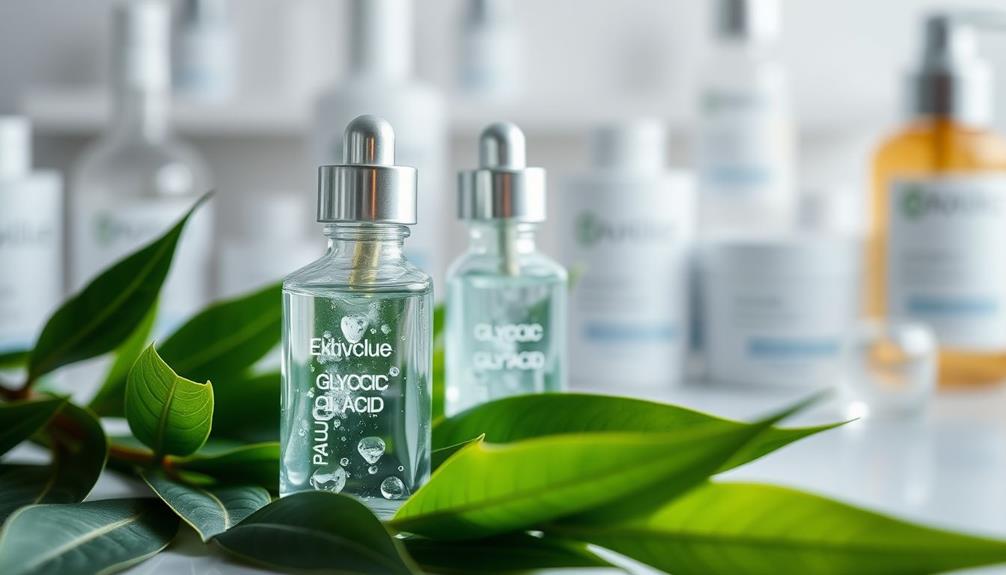
Glycolic acid is a powerful alpha hydroxy acid (AHA) derived from sugarcane that effectively exfoliates your skin by dissolving the bonds between dead skin cells. Its unique exfoliating properties help improve your skin texture, making it smoother and more radiant.
By promoting cell turnover, glycolic acid encourages your skin to shed old, damaged cells while revealing fresh, healthy ones underneath. Additionally, incorporating crucial oils for skin health can further enhance your skincare routine by providing anti-inflammatory benefits.
This makes glycolic acid a popular choice for acne treatment. It unclogs pores, reduces inflammation, and helps prevent future breakouts. Regular use can minimize the appearance of acne scars and address hyperpigmentation caused by previous acne lesions or sun exposure.
You'll find glycolic acid in various formulations, such as serums, creams, and peels, with concentrations varying from 5% to 70%. This variety allows you to select the right product based on your skin type and sensitivity.
However, it's important to start with lower concentrations to gauge your skin's reaction, especially if you have sensitive skin. Gradually increasing the concentration can help you maximize the benefits while minimizing irritation.
Understanding glycolic acid's role can greatly enhance your skincare routine.
Benefits of Glycolic Acid for Acne
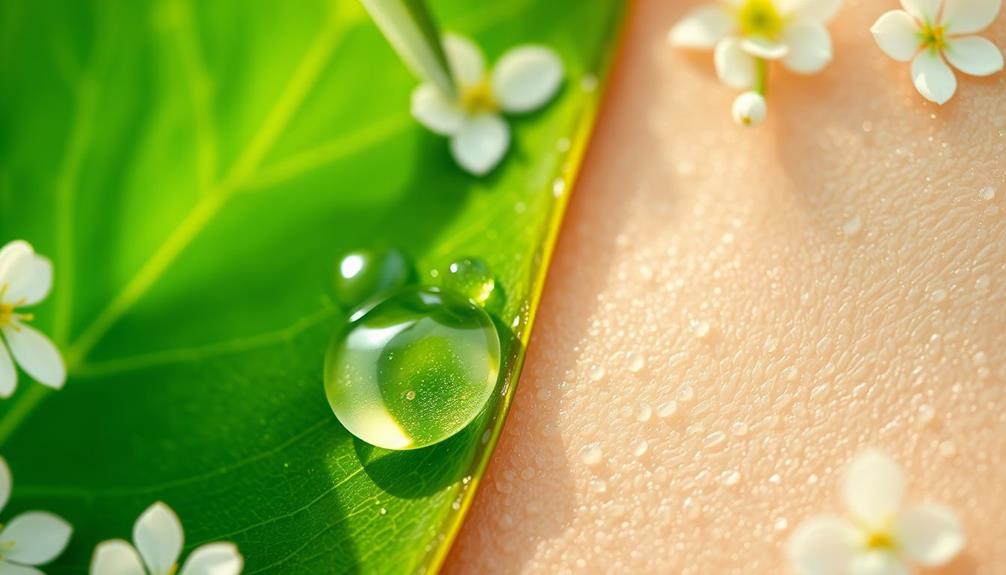
The benefits of glycolic acid for acne include its ability to effectively reduce breakouts and improve overall skin texture by promoting cell turnover. This alpha hydroxy acid (AHA) boasts powerful exfoliating properties that help prevent clogged pores, which are a common cause of acne.
Additionally, just as cats may display affection upon their owner's return, the consistent use of glycolic acid can lead to noticeable improvements in skin health and texture. By regularly using glycolic acid, you can see a significant reduction in acne lesions and overall acne severity, particularly with consistent application over time.
Glycolic acid works by dissolving the bonds between dead skin cells, leading to smoother skin texture. This not only minimizes the appearance of acne scars but also helps reduce post-inflammatory hyperpigmentation.
Additionally, glycolic acid enhances moisture retention in the skin, making it a great option for acne-prone individuals. It balances oil production, which can further decrease the likelihood of new breakouts.
Incorporating glycolic acid into your skincare routine, ideally in lower concentrations (5-10%), can effectively manage acne while minimizing the risk of irritation. By making this addition, you're taking a proactive step towards clearer skin and improved overall skin health.
How to Use Glycolic Acid
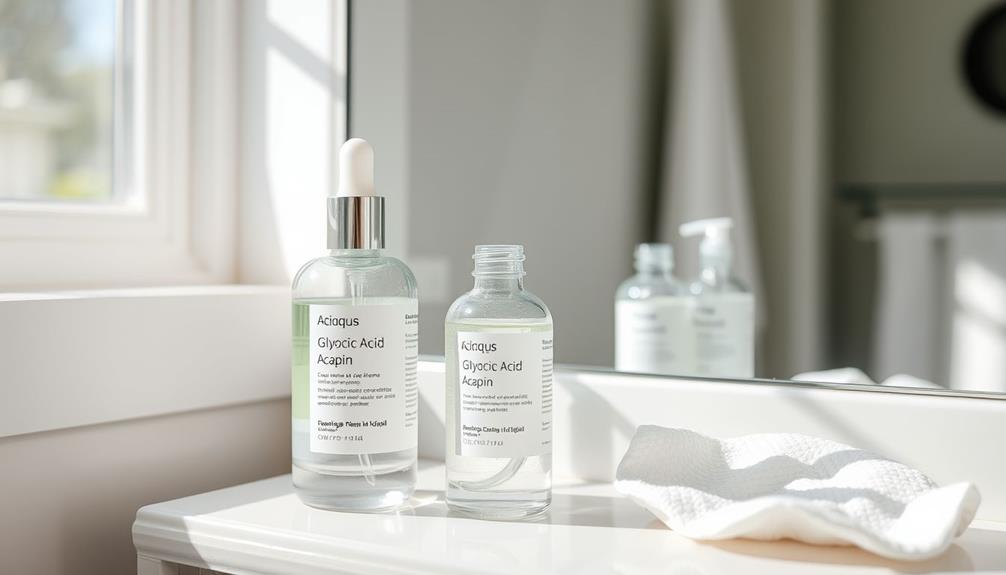
When using glycolic acid, it's important to focus on application techniques, frequency guidelines, and product selection.
Consider incorporating a well-maintained air purifier to enhance your skincare environment, as air purifiers improve indoor air quality considerably.
Start with a lower concentration and adjust based on how your skin reacts.
Application Techniques
Start with a lower concentration of glycolic acid, around 5-10%, to gauge how your skin reacts before increasing usage. Proper application techniques are vital to maximize benefits while minimizing irritation.
Follow these steps for ideal results:
- Cleanse: Thoroughly cleanse your skin to remove dirt and oil. This guarantees glycolic acid can penetrate effectively.
- Apply: Use glycolic acid as the first step in your nighttime routine. Avoid applying other AHAs or BHAs simultaneously to prevent excessive irritation.
- Moisturize: After applying glycolic acid, follow up with a moisturizer. This helps support your skin barrier and mitigates irritation, especially if your moisturizer contains ceramides.
- Protect: Always finish your daytime routine with a broad-spectrum sunscreen of at least SPF 30. Glycolic acid increases sun sensitivity, so proper protection is essential to prevent skin damage.
Frequency Guidelines
Determine your skin's tolerance by initially using glycolic acid once or twice a week before gradually increasing the frequency.
Start with lower concentrations, around 5-10%, to minimize irritation.
Allow your skin to acclimate before increasing the application to 1-3 times per week, based on how your skin responds.
When applying glycolic acid, do so on cleansed skin before your moisturizer, ideally at night.
This timing helps reduce the risk of sun sensitivity.
It's essential to monitor your skin response closely.
If you notice any irritation, scale back your usage until your skin adjusts.
Once you feel comfortable, you can gradually increase the frequency to achieve ideal results.
Product Selection
Choosing the right glycolic acid product can greatly enhance your acne treatment routine. To make the best product selection, consider these key factors:
- Concentration: Start with lower concentrations of glycolic acid (5-10%) to assess your skin's tolerance.
- Frequency: Apply it 1-3 times a week initially to minimize irritation, then gradually increase frequency as your skin adjusts.
- Application: Always apply glycolic acid to clean, dry skin before using moisturizers. Doing this at night helps reduce sun sensitivity.
- Sunscreen: Since glycolic acid can make your skin more sensitive to UV rays, following up with a broad-spectrum sunscreen during the day is essential.
Avoid using multiple glycolic acid products simultaneously; this can lead to irritation. Instead, pair glycolic acid with gentle moisturizers to maintain hydration and support your skin barrier.
Potential Side Effects

Using glycolic acid can lead to potential side effects, including swelling, itching, and burning sensations, particularly for those with dry or sensitive skin.
If you have sensitive skin, you should be cautious when introducing glycolic acid into your routine. Higher concentrations, especially those above 10%, may increase the risk of irritation, so it's advisable to use them only under the supervision of a dermatologist.
You should also be aware that glycolic acid can make your skin more sensitive to the sun, necessitating daily sunscreen application. This added sun sensitivity can exacerbate side effects and increase the risk of hyperpigmentation, particularly in individuals with darker skin tones.
If you notice any adverse reactions, it's essential to discontinue use immediately and consult a dermatologist for guidance.
Monitoring your skin's response is important, as discontinuation may be necessary if irritation occurs. Being proactive about your skincare choices can help you achieve the desired results while minimizing potential side effects.
Always prioritize your skin's health and seek professional advice if you're unsure about using glycolic acid.
Safety Precautions
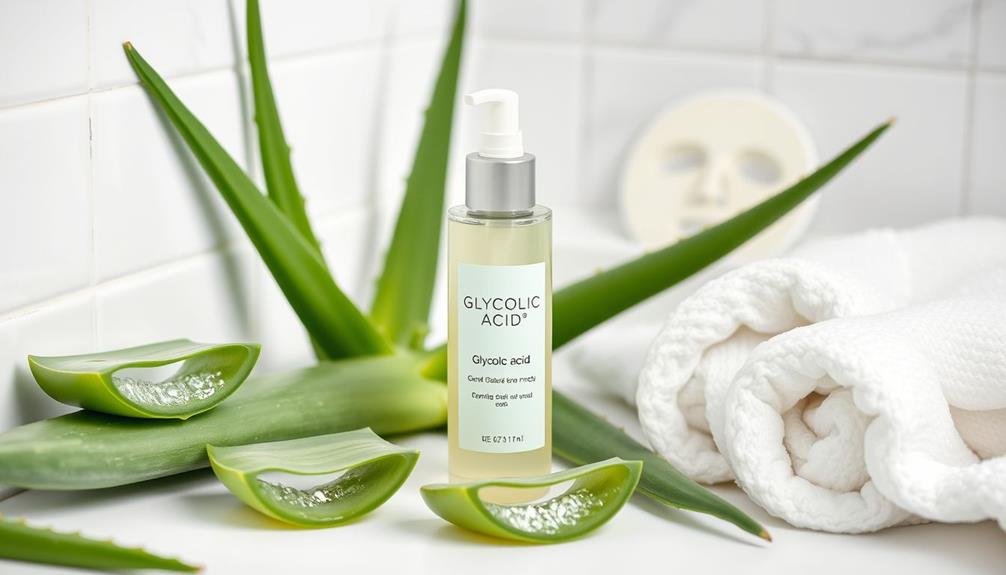
To guarantee safe usage of glycolic acid, start with lower concentrations and gradually increase as your skin adapts. This approach minimizes the risk of skin irritation, especially if you have sensitive skin.
Here are some important safety precautions to keep in mind:
- Begin with lower concentrations: Use products with 5-10% glycolic acid initially to gauge your skin's reaction.
- Limit frequency: Apply glycolic acid 1-3 times per week at first. As your skin builds tolerance, you can increase usage gradually.
- Consult a dermatologist: If you have darker skin tones or are considering higher concentrations (30% and above), it's essential to discuss this with a dermatologist to avoid irritation and hyperpigmentation.
- Use sunscreen: Glycolic acid can increase sun sensitivity, so always apply a broad-spectrum sunscreen with at least SPF 30 daily to protect your skin.
Professional Treatments Available
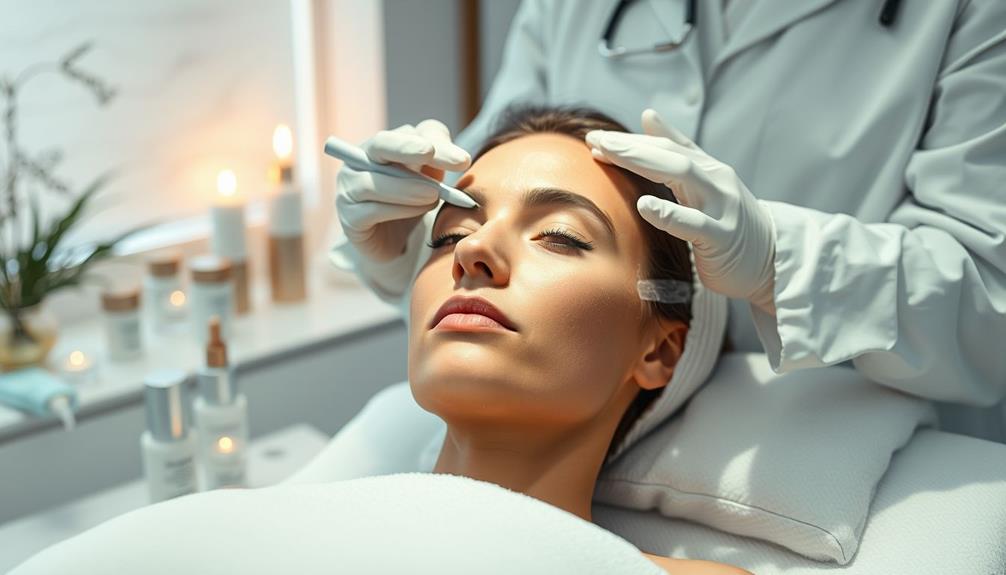
When considering professional glycolic acid treatments, you'll find various types of peels designed to cater to your skin's specific needs.
It's important to understand how often these treatments should be performed and what kind of results you can expect afterward.
Let's explore the different peel options, recommended treatment frequencies, and the recovery process you might experience.
Types of Professional Peels
Professional glycolic acid peels offer a powerful treatment option for acne and other skin concerns, delivering deeper exfoliation through higher concentrations that can greatly enhance your skin's appearance.
These professional glycolic acid peels typically range from 30-70% in concentration, ensuring effective chemical exfoliation when performed under dermatologist supervision.
Here are four types of professional glycolic acid peels you might consider:
- Superficial Peels: Ideal for mild acne and surface-level concerns, these peels use lower concentrations and require minimal downtime.
- Medium Peels: Suitable for moderate acne and hyperpigmentation, these peels penetrate deeper layers of the skin, promoting significant improvement after several sessions.
- Deep Peels: Often used for severe acne and deep wrinkles, these peels provide powerful results but require careful post-peel care and longer recovery times.
- Customized Peels: Tailored to your specific skin concerns, these peels combine glycolic acid with other ingredients for a personalized approach.
Treatment Frequency Recommendations
Understanding how often to schedule glycolic acid treatments can greatly impact your results, especially after exploring the different types of professional peels available.
For mild glycolic acid peels containing 10-15% concentration, you can typically use them 1-3 times a week.
However, for higher concentrations ranging from 30-70%, it's vital to seek professional supervision.
Dermatologists often recommend starting with lower concentrations if you have sensitive skin and gradually increasing the treatment frequency as your skin builds tolerance.
When it comes to more severe acne types, such as papulo-pustular acne, you might need an average of six glycolic acid peel sessions for noticeable improvement.
Nodular-cystic acne may require eight to ten treatments to effectively reduce acne scarring.
Continuous monitoring of your skin response is essential; you should adjust your treatment frequency based on how your skin reacts to each session.
By paying attention to these guidelines, you can maximize the benefits of glycolic acid peels while minimizing the risk of irritation or adverse reactions.
Always consult with a skincare professional to tailor the treatment plan to your specific needs.
Expected Results and Recovery
Expect to see significant improvements in your acne and skin texture after multiple glycolic acid treatments, especially with higher concentrations used in professional settings. Glycolic acid peels can effectively reduce acne lesions and enhance your overall complexion.
Here's what you can generally expect during recovery and results:
- Initial Improvements: After a few treatments, comedonic acne often shows the quickest response.
- Moderate Side Effects: Expect mild redness and peeling, lasting a few days to a week, depending on the peel's strength.
- Multiple Sessions: Clinical studies suggest that more severe acne types, like papulo-pustular, may require around six sessions to achieve satisfactory improvements.
- Post-Treatment Care: To maximize recovery, maintain a consistent skincare routine and always apply sunscreen to protect your skin from further damage.
Clinical Evidence and Studies

Numerous clinical studies consistently demonstrate the effectiveness of glycolic acid in reducing acne lesions and improving skin quality.
A study published in the Journal of the American Academy of Dermatology showed significant reductions in acne among participants using glycolic acid products regularly.
Furthermore, research in the Journal of Cosmetic Dermatology highlighted how glycolic acid peels effectively decreased sebum production and enhanced skin texture in individuals with acne vulgaris.
Clinical trials have confirmed that glycolic acid is particularly beneficial for treating comedonic acne. Many participants experienced rapid improvement after just a few peel applications.
In a randomized trial comparing 30% glycolic acid peels with other treatments, glycolic acid exhibited superior efficacy in reducing papulo-pustular and nodular-cystic forms of acne.
What's more, studies indicate that consistent use of glycolic acid not only lessens acne severity but also boosts overall skin quality.
It promotes collagen production and accelerates cell turnover, essential factors for healthier skin.
Expert Opinions and Insights

Experts in dermatology widely agree on glycolic acid's role in acne treatment, highlighting its ability to unclog pores and reduce inflammation effectively. This makes it a go-to choice for many dermatologists. Here are some expert insights that can guide you: When choosing a glycolic acid product for acne treatment, it’s important to consider the concentration and formulation. Higher concentrations may be more effective but can also be harsh on the skin, so it’s important to start with a lower concentration and gradually increase as tolerated. Additionally, incorporating glycolic acid into a consistent skincare routine can help maintain clear skin and prevent future breakouts. Understanding the glycolic acid benefits for acne can help individuals make informed decisions about their skincare routine and treatment options.
- Start Slow: Begin with lower concentrations of glycolic acid, especially if you have sensitive skin, to minimize irritation while still enjoying its exfoliating properties.
- Combine Wisely: Incorporating glycolic acid into a well-rounded skincare routine—like gentle cleansing and moisturizing—can enhance its effectiveness in managing acne and promoting skin health.
- Monitor Your Skin: Individual responses to glycolic acid can vary, so keep an eye on how your skin reacts and be ready to adjust your routine.
- Consult a Dermatologist: For the best results, consult a dermatologist to create personalized treatment plans that address your unique skin concerns, including potential risks like irritation or hyperpigmentation.
Recommended Skincare Routine
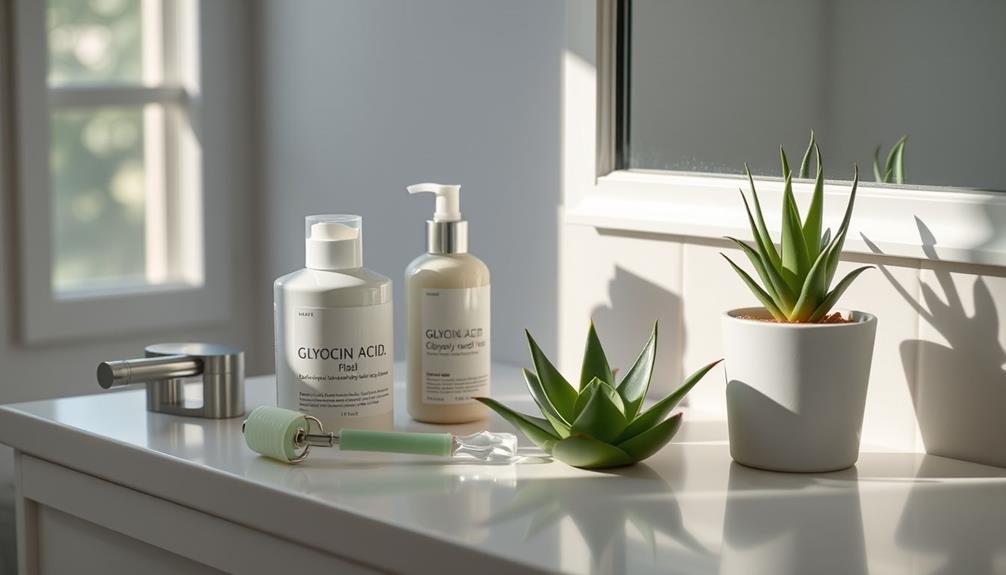
A well-structured skincare routine is vital for effectively incorporating glycolic acid into your acne treatment plan. Start by selecting a product with a lower concentration of glycolic acid, around 5-10%, and use it 1-3 times per week. This gradual introduction helps you build tolerance, especially if you have sensitive skin.
Begin your routine with a gentle cleanser to prepare your skin. After cleansing, apply the glycolic acid product, allowing it to absorb fully before moving on to the next step. Follow up with a moisturizing cream, ideally one that contains ceramides, to support your skin barrier and combat dryness.
Since glycolic acid can increase sun sensitivity, it's important to prioritize sun protection during the day. Always apply a broad-spectrum sunscreen to shield your skin from harmful UV rays.
Monitor your skin's response to the glycolic acid and adjust its frequency as needed. This tailored approach guarantees your skincare routine effectively manages acne while minimizing irritation, leading to healthier, clearer skin over time.
Frequently Asked Questions
How Effective Is Glycolic Acid for Acne?
Glycolic acid's highly effective for acne. It promotes cell turnover, unclogs pores, and reduces inflammation. Regularly using it can lead to clearer skin and fewer breakouts, making it a solid addition to your skincare routine.
Do Dermatologists Recommend Glycolic Acid?
Yes, dermatologists recommend glycolic acid for its ability to exfoliate and unclog pores. They suggest starting with lower concentrations to see how your skin reacts before gradually increasing for better results.
How Long Does It Take for Glycolic Acid to Clear Acne?
Imagine a garden overrun with weeds. With consistent care, you'll see improvements in about 4 to 6 weeks. Patience is key; after 3 to 4 months, your skin can bloom beautifully, free from blemishes.
Does Glycolic Acid Get Rid of Hormonal Acne?
Yes, glycolic acid can help get rid of hormonal acne. It exfoliates dead skin cells, unclogs pores, and reduces inflammation, making it effective for managing breakouts and improving skin texture over time.
Conclusion
Incorporating glycolic acid into your skincare routine can be a game-changer for acne management.
Studies show that up to 60% of people see a significant improvement in their skin texture and breakouts after consistent use.
By exfoliating dead skin cells and unclogging pores, glycolic acid helps reveal clearer, healthier skin.
Just remember to start slow and listen to your skin.
Embrace the science, and you might just reveal your best complexion yet!
